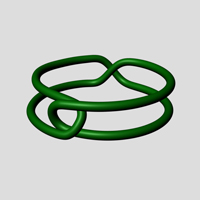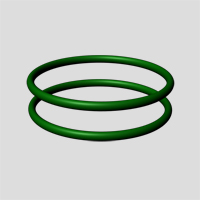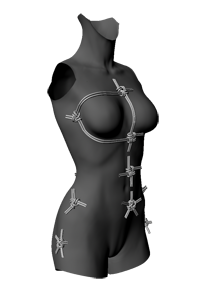You know quite a lot about knots now. But we haven’t achieved any bondage yet. As you probably anticipate, knowing knots is not enough. But we are much closer to a bondage, because we know how they work. What we need now is a powerful process that can turn any sketch into a real bondage. As this process will rely on our previous results, let us summarize them a little bit.
- A bondage is a closed loop.
- Elementary knots can be straight, crossed or zeroed.
- All knots have branches with double rope ends.
- Complex Knots are black boxes. We have 21 regular knots to pick from.
- Knots are closed and made of groups.
Now let’s go!
Let’s draw a sketch, place some knots and see what separates us from the bondage we intended.
Body and sketch : First attempt
|
Fig. a : Bondage position |
|
|
Fig. b : Sketch with doubled rope. |
|
|
Fig. c : Knots selection. |
|
|
Let's pick one bondage position (Fig. a), then draw some good sketch on it (Fig. b). Then place some good knots where the crossings are located (Fig. c). So far we've followed all the rules that were established in the previous chapters.
After the sketch is done and the knots are placed, don’t you feel compelled to connect all those knots together? I sure do!!!
As an example let’s just do it. Let’s just connect them. (Fig. d)
And… Here you go!
Done. Congratulations!
You’ve just obtained … an unachievable set of closed loops.
After 3 connections only indeed (Fig. e), you can realize that the rope is closing on to itself. We created a sub-group on its own that is not linked to the rest of the bondage.
You may feel disappointed right now. But actually you’ve just made a big step forward to the solution
|
|
|
Now WHAT does this experiment mean?
It just means that our process could be complete if we could merge those loops together.
I propose you to study this situation and find the way to do it!
Complementary rules
Closed loops standing apart from each-other are just virtually connected by an elementary knot : the Zero type knot. We can say that 2 links are basically in interaction through 2 knots of type 0 (non-binding) as shown in the following examples :

|
= |

|
Connecting the loops just means you have to replace this 0 knot by a +1 or a -1 type.
As you can see in the following, replacing one 0 knot between two closed loops by a +1 or a -1 knot will result in a merged continuous loop. (Let's say we replaced the one in the back).

|
or |

|
What if the links interact already? Merging and merging is not always successful… Replacing twice a 0 knot by a +1 knot would split the ropes again!
And same thing would occur if you replace two 0 knots by -1 ones! Links interacting through one given type of elementary knot will merge (or stay merged) if the second interaction is of a different type. In other words if the new interaction is of the same type than the existing one, they will split.
We shall call this rule "The Complementary Rule". You can see here below, how 2 links split if linked twice with the same elementary type.

|
or |

|
On the left hand side, two links split when linked twice with a +1 knot. On the right hand side, two links split when linked twice with a -1 knot. You can now know in advance whether 2 links will merge or split depending on the elementary knots that you use.
In some cases, 2 complex knots facing each-other will unavoidably result in an unconnected portion.
The solution here is obviously to replace one of the knots by another one from the table, that has the same number of branches.











